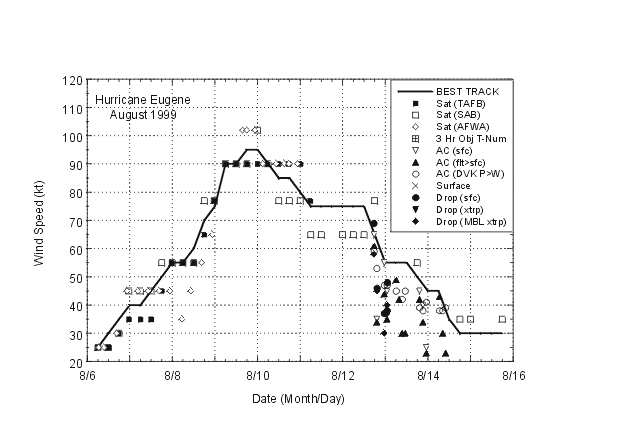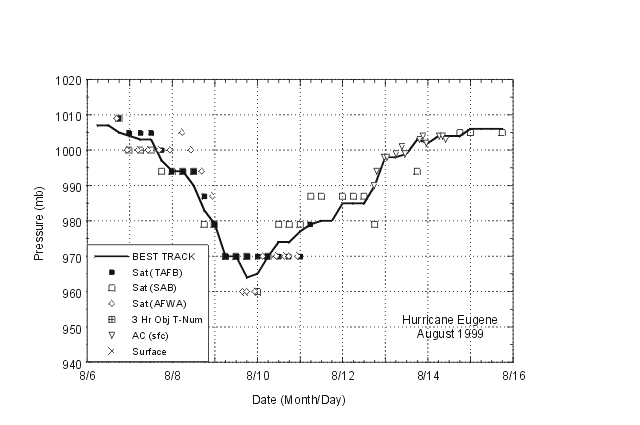a. Synoptic History
A westward-moving tropical wave crossed Central America on 28-29 July. For
the next few days, the system continued westward at 10- 15 knots over the
tropical eastern Pacific, enhancing convection along the ITCZ but showing
little evidence of organization. Late on 5 August, as the wave neared
120W, the associated cloud pattern become more consolidated and by 0600 UTC
6 August, the organization had improved significantly, with curved cloud
bands evident on satellite images. Based on the organization of the cloud
pattern, it is estimated that Tropical Depression Eight-E formed at this
time, centered about 850 n mi southwest of Cabo San Lucas. Data T-numbers
from the Dvorak technique suggest that the depression became a tropical
storm, Eugene, by 1800 UTC 6 August, while centered about 900 n mi
southwest of Cabo San Lucas.
For the first couple of days, with a slight weakness in the subtropical
ridge to its north, the tropical cyclone moved generally west-northwestward
at less than 10 knots. By 8 August, however, the ridge to the north of
Eugene strengthened, forcing the cyclone on a westward course at 10-11
knots. Eugene intensified into a hurricane a little before 1800 UTC that
day, as a small eye about 10 n mi in diameter was observed on the satellite
pictures. Stronger ridging to the north caused the system to move slightly
south of west, keeping it over warmer sea surface temperatures. Additional
strengthening occurred until the hurricane reached its peak intensity of
about 95 knots around 1800 UTC 9 August. It should be noted that this
cyclone reached its maximum intensity near 133W longitude, significantly
farther west than the typical location at which eastern north Pacific
tropical cyclones reach their peak strength. Shortly thereafter, a slow
weakening trend commenced. Eugene moved westward and entered the Central
Pacific basin, as a 75-knot hurricane, early on 11 August.
In an environment of modest shear and marginal (for strengthening) sea
surface temperatures, the cyclone was quite slow to wind down. Eugene
eventually weakened below hurricane strength by 0000 UTC 13 August, while
centered about 550 n mi east-southeast of the island of Hawaii. The storm
passed a little less than 300 n mi south of the southern end of the island
of Hawaii at 0600 UTC 14 August, by which time its maximum sustained winds
had diminished to near 45 knots. Eugene turned west-southwestward toward a
region of increasing vertical shear. The cyclone weakened to
a depression later on the 14th, then turned back toward the west
and dissipated, a little over 500 n mi southeast of Johnston Island, on 15
August.
b. Meteorological Statistics
Table 1 is a listing of the post-storm "best" track
positions and intensities of Eugene at six-hourly intervals. West of 140W
longitude, the best track was produced by the
Central Pacific Hurricane Center (CPHC) in Honolulu, Hawaii.
Figure 1 is a map of the best track.
Figure 2 and Figure 3 show curves of
the maximum one-minute average "surface" (10 meters above ground level) wind
speed and minimum central sea-level pressure, respectively, as a function of
time. Also plotted are the observations on which the curves are based,
consisting of aircraft reconnaissance and dropsonde data from the U.S. Air
Force Reserves (the Hurricane Hunters) as well as Dvorak-technique estimates
from the Tropical Analysis and Forecast Branch (TAFB), the Satellite
Analysis Branch (SAB), and the U.S. Air Force Weather Agency (AFWA) using
satellite imagery. In Figure 2, the aircraft flight level
wind measurements have been adjusted for elevation (90% of 700 mb wind
speeds and 80% of 850 mb speeds), and dropsonde wind measurements that fail
above the surface are adjusted to the 10 meter level using a mean hurricane
eyewall profile determined by previous dropsonde measurements.
Prior to its entrance into the CPHC's area of responsibility, the intensity
of Eugene was estimated solely on the basis of satellite images. The
estimated peak strength, 95 knots, is a compromise between Dvorak estimates
from AFWA, SAB, and TAFB.
c. Casualty and Damage Statistics
No reports of casualties or damages due to Eugene have been received.
d. Forecast and Warning Critique
In comparison to the long-term average, Eugene's track was reasonably well
forecast, although there was almost always a slight northward bias in the
National Hurricane Center and CPHC track predictions. During the
strengthening phase of the tropical cyclone, practically all of the
official forecasts under-predicted the intensity of Eugene, at times by as
much as 30 to 35 knots. Afterwards the intensity was, for the most part,
slightly over-predicted.
The CPHC correctly forecast Eugene to remain safely south of the Hawaiian
island chain. Watches and/or warnings were not required.

Figure 1.
Best track positions for Hurricane Eugene, 6-15 August, 1999

Figure 2.
Best track maximum sustained wind speed curve for Hurricane Eugene, showing
all available intensity estimates and wind observations. Aircraft
flight-level winds are adjusted for elevation (90% of 700 mb flight level
wind speeds and 80% of 850 mb speeds). Dropsonde wind speeds are adjusted
to the surface using a mean eyewall profile determined from previous
dropsonde measurements. MBL denotes mean boundary layer).

Figure 3.
Best track minimum central pressure curve and central pressure observations
for Hurricane Eugene.
Table 1.
Best track, Hurricane Eugene, 6-15 August, 1999
Date/Time
(UTC) |
Position |
Pressure
(mb) |
Wind Speed
(kt) |
Stage |
| Lat. (°N) |
Lon. (°W) |
| 6/0600 | 12.2 | 119.9 | 1007 | 25 | tropical depression |
| 6/1200 | 12.3 | 120.4 | 1007 | 30 | " |
| 6/1800 | 12.6 | 121.1 | 1005 | 35 | tropical storm |
| 7/0000 | 12.9 | 122.0 | 1004 | 40 | " |
| 7/0600 | 13.2 | 122.8 | 1003 | 40 | " |
| 7/1200 | 13.5 | 123.6 | 1003 | 45 | " |
| 7/1800 | 13.9 | 124.4 | 997 | 50 | " |
| 8/0000 | 14.3 | 125.4 | 994 | 55 | " |
| 8/0600 | 14.4 | 126.3 | 994 | 55 | " |
| 8/1200 | 14.6 | 127.2 | 990 | 60 | " |
| 8/1800 | 14.8 | 128.2 | 983 | 70 | hurricane |
| 9/0000 | 14.9 | 129.3 | 979 | 75 | " |
| 9/0600 | 14.5 | 130.3 | 970 | 90 | " |
| 9/1200 | 14.3 | 131.4 | 970 | 90 | " |
| 9/1800 | 14.0 | 132.4 | 964 | 95 | " |
| 10/0000 | 14.0 | 133.5 | 965 | 95 | " |
| 10/0600 | 13.8 | 134.5 | 970 | 90 | " |
| 10/1200 | 13.7 | 135.6 | 974 | 85 | " |
| 10/1800 | 13.7 | 136.7 | 974 | 85 | " |
| 11/0000 | 13.7 | 138.1 | 977 | 80 | " |
| 11/0600 | 13.8 | 139.3 | 979 | 75 | " |
| 11/1200 | 13.9 | 140.4 | 980 | 75 | " |
| 11/1800 | 14.0 | 141.5 | 980 | 75 | " |
| 12/0000 | 14.2 | 142.5 | 985 | 75 | " |
| 12/0600 | 14.4 | 143.6 | 985 | 75 | |
| 12/1200 | 14.6 | 144.6 | 985 | 75 | " |
| 12/1800 | 14.8 | 145.8 | 990 | 65 | " |
| 13/0000 | 14.8 | 146.9 | 998 | 55 | tropical storm |
| 13/0600 | 14.7 | 148.0 | 998 | 55 | " |
| 13/1200 | 14.7 | 149.3 | 999 | 55 | " |
| 13/1800 | 14.7 | 150.7 | 1003 | 50 | " |
| 14/0000 | 14.7 | 152.1 | 1002 | 45 | " |
| 14/0600 | 14.5 | 153.6 | 1004 | 45 | " |
| 14/1200 | 14.1 | 155.0 | 1004 | 35 | " |
| 14/1800 | 13.7 | 156.3 | 1004 | 30 | tropical depression |
| 15/0000 | 13.1 | 157.5 | 1006 | 30 | " |
| 15/0600 | 12.5 | 158.8 | 1006 | 30 | " |
| 15/1200 | 12.2 | 160.3 | 1006 | 30 | " |
| 15/1800 | 12.1 | 161.8 | 1006 | 30 | " |
| 16/0000 | | dissipated |
| |
| 9/1800 | 14.0 | 132.4 | 964 | 95 |
minimum pressure |
![[NCEP Logo]](graphics/ncep.gif)